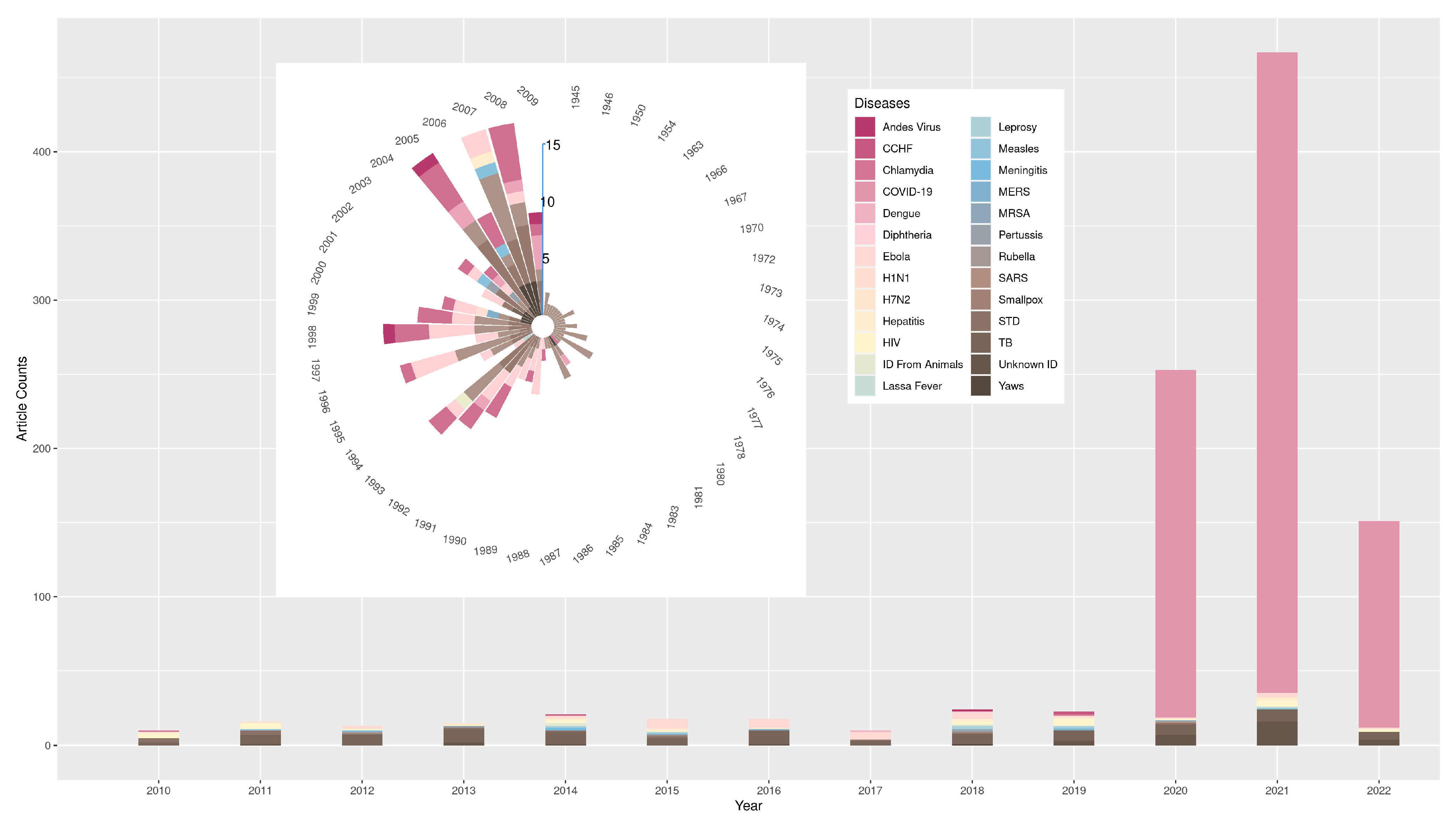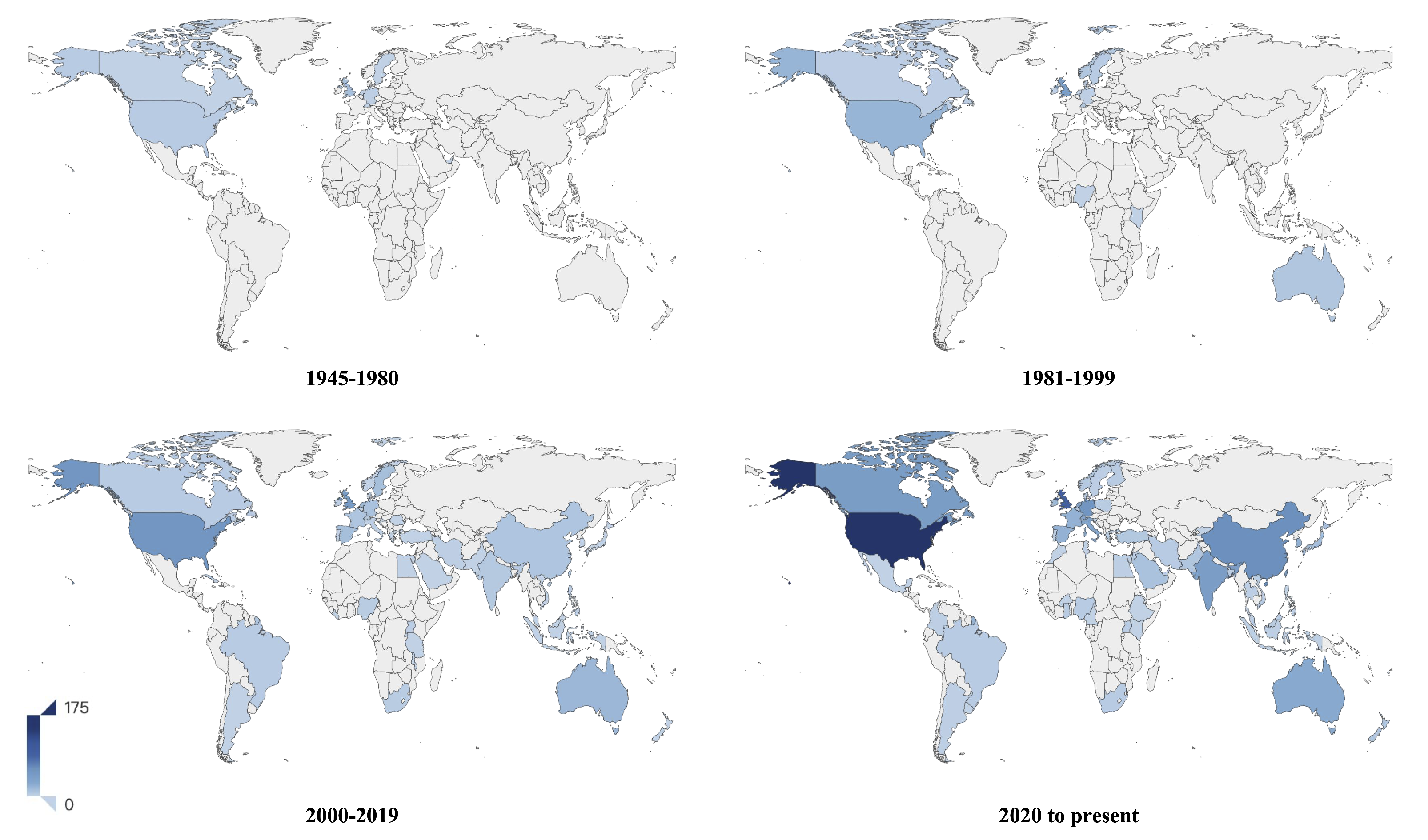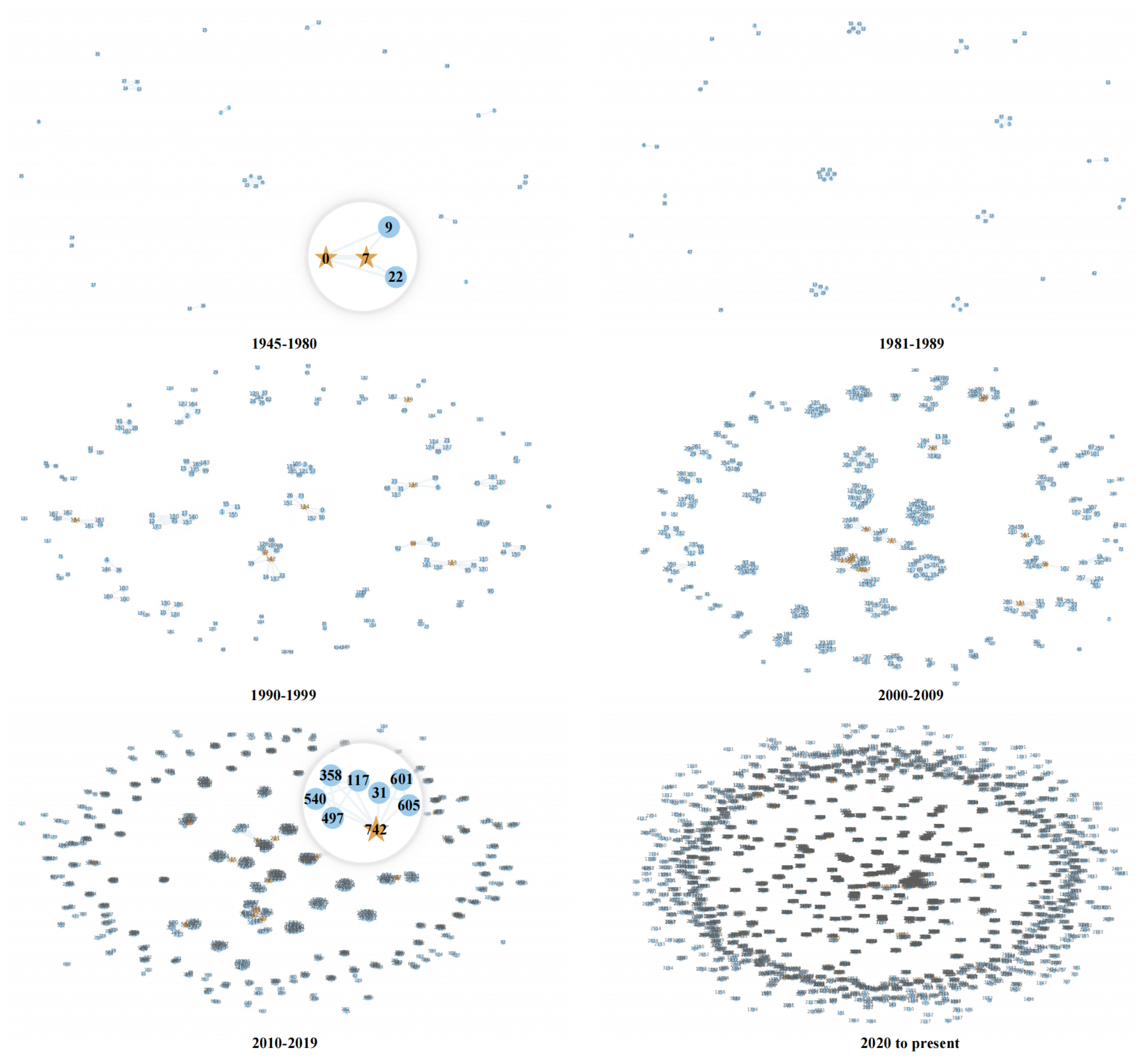Contact Tracing Research: A Literature Review Based on Scientific Collaboration Network
Abstract
1. Introduction
- How has the research field of contact tracing evolved? What are the characteristics of the different stages?
- Which disease occupies the largest proportion of contact tracing research?
- What is the current status of scientific research cooperation in this field?
2. Background
2.1. Contact Tracing
2.2. Scientific Collaboration Network
2.3. Social Network Analysis
3. Data and Methodology
3.1. Data Sources
3.2. Methodology
3.2.1. Network Cooperative Closeness
3.2.2. Average Shortest Path Length
3.2.3. Average Clustering Coefficient
3.2.4. Community Detection
| Algorithm 1: CL-SLPA |
 |
4. Results and Discussion
4.1. Literature Data Analysis
4.1.1. The Distribution Characteristics of Literature Data
4.1.2. Co-Author Distribution of Literature
4.1.3. Country Distribution of Literature
4.2. Structure of CTSCN
4.2.1. Basic Characteristics of the Network
4.2.2. Network Community and Connected Subgraph Analysis
5. Conclusions
Author Contributions
Funding
Institutional Review Board Statement
Informed Consent Statement
Data Availability Statement
Acknowledgments
Conflicts of Interest
References
- Armbruster, B.; Brandeau, M. Contact tracing to control infectious disease: When enough is enough. Health Care Manag. Sci. 2008, 10, 341–355. [Google Scholar] [CrossRef]
- Wailes, M. The social aspect of the venereal diseases-2: Contact tracing and the prostitute. Br. J. Vener. Dis. 1945, 21, 15–17. [Google Scholar] [CrossRef] [PubMed][Green Version]
- Kleinman, R.A.; Merkel, C. Digital contact tracing for COVID-19. CMAJ Can. Med. Assoc. J. = J. L’Association Medicale Can. 2020, 192, E653–E656. [Google Scholar] [CrossRef] [PubMed]
- Svoboda, T.; Henry, B.; Shulman, L.; Kennedy, E.; Rea, E.; Ng, W.; Wallington, T.; Yaffe, B.; Gournis, E.; Vicencio, E.; et al. Public Health Measures to Control the Spread of the Severe Acute Respiratory Syndrome during the Outbreak in Toronto. N. Engl. J. Med. 2004, 350, 2352–2361. [Google Scholar] [CrossRef] [PubMed]
- WHO. WHO Health Emergency Dashboard. 2022. Available online: https://covid19.who.int/ (accessed on 17 June 2022).
- Zhang, J.; Litvinova, M.; Wang, W.; Wang, Y.; Deng, X.; Chen, X.; Li, M.; Zheng, W.; Yi, L.; Chen, X.; et al. Evolving epidemiology and transmission dynamics of coronavirus disease 2019 outside Hubei province, China: A descriptive and modelling study. Lancet Infect. Dis. 2020, 20, 793–802. [Google Scholar] [CrossRef]
- Ahmed, N.; Michelin, R.A.; Xue, W.; Ruj, S.; Malaney, R.; Kanhere, S.S.; Seneviratne, A.; Hu, W.; Janicke, H.; Jha, S.K. A Survey of COVID-19 Contact Tracing Apps. IEEE Access 2020, 8, 134577–134601. [Google Scholar] [CrossRef]
- Liu, D.; Song, M.; Xie, Y.; Feng, Y.; Liu, Q. Analysis of ESI highly cited papers supported by NSFC during 2009-2015. Bull. Natl. Nat. Sci. Found. China 2017, 31, 353–358. [Google Scholar] [CrossRef]
- Grubaugh, N.; Ladner, J.; Lemey, P.; Pybus, O.; Rambaut, A.; Holmes, E.; Andersen, K. Tracking virus outbreaks in the twenty-first century. Nat. Microbiol. 2018, 4, 10–19. [Google Scholar] [CrossRef]
- Chien, T.W.; Chang, Y.; Wang, H.Y. Understanding the productive author who published papers in medicine using National Health Insurance Database: A systematic review and meta-analysis. Medicine 2018, 97, e9967. [Google Scholar] [CrossRef]
- Basir Ghafouri, H.; Mohammadhassanzadeh, H.; Shokraneh, F.; Vakilian, M.; Farahmand, S. Social network analysis of Iranian researchers on emergency medicine: A sociogram analysis. Emerg. Med. J. 2013, 31, 619–624. [Google Scholar] [CrossRef] [PubMed]
- González-Alcaide, G.; Jinseo, P.; Huamaní, C.; Gascón, J.; Ramos Rincón, J.M. Scientific authorships and collaboration network analysis on Chagas disease: Papers indexed in PubMed (1940–2009). Rev. Inst. Med. Trop. São Paulo 2012, 54, 219–228. [Google Scholar] [CrossRef] [PubMed]
- Lunny, C.; Shearer, B. A systematic review and comparison of HIV contact tracing laws in Canada. Health Policy 2011, 103, 111–123. [Google Scholar] [CrossRef] [PubMed]
- Saunders, M.; Koh, G.; Small, A.; Dedicoat, M. Predictors of contact tracing completion and outcomes in tuberculosis: A 21-year retrospective cohort study. Int. J. Tuberc. Lung Dis. 2014, 18, 640–646. [Google Scholar] [CrossRef] [PubMed]
- Ross, J.; Black, A. Contact tracing and antiviral prophylaxis in the early stages of a pandemic: The probability of a major outbreak. Math. Med. Biol. 2014, 32, 331–343. [Google Scholar] [CrossRef]
- Sacks, J.; Zehe, E.; Redick, C.; Bah, A.; Cowger, K.; Camara, M.; Diallo, A.; Gigo, A.; Dhillon, R.; Liu, A. Introduction of Mobile Health Tools to Support Ebola Surveillance and Contact Tracing in Guinea. Glob. Health Sci. Pract. 2015, 3, 646–659. [Google Scholar] [CrossRef]
- Racelis, S.; de Los Reyes, V.C.; Sucaldito, M.N.; Deveraturda, I.; Roca, J.; Tayag, E. Contact tracing the first Middle East respiratory syndrome case in the Philippines, February 2015. West. Pac. Surveill. Response J. 2015, 6, 3–7. [Google Scholar] [CrossRef]
- Malheiro, R.; Figueiredo, A.; Magalhaes, J.; Teixeira, P.; Moita, I.; Moutinho, M.; Mansilha, R.; Gonçalves, L.; Ferreira, E. Effectiveness of contact tracing and quarantine on reducing COVID-19 transmission: A retrospective cohort study. Public Health 2020, 189, 54–59. [Google Scholar] [CrossRef] [PubMed]
- Chen, H.; Yang, B.; Pei, H.; Liu, J. Next Generation Technology for EpidemicPrevention and Control: Data-Driven Contact Tracking. IEEE Access 2018, 7, 2633–2642. [Google Scholar] [CrossRef]
- O’Connell, J.; Abbas, R.; Beecham, S.; Buckley, J.; Chochlov, M.; Fitzgerald, B.; Glynn, L.; Johnson, K.; Laffey, J.; Mcnicholas, B.; et al. Best Practice Guidance for Digital Contact Tracing Apps: A Cross-Disciplinary Review of the Literature. JMIR Mhealth Uhealth 2021, 9, e27753. [Google Scholar] [CrossRef]
- Akinbi, A.; Forshaw, M.; Blinkhorn, V. Contact tracing apps for the COVID-19 pandemic: A systematic literature review of challenges and future directions for neo-liberal societies. Health Inf. Sci. Syst. 2021, 9, 18. [Google Scholar] [CrossRef]
- Hossain, A.; Jarolimova, J.; Elnaiem, A.; Huang, C.; Richterman, A.; Ivers, L. Effectiveness of contact tracing in the control of infectious diseases: A systematic review. Lancet Public Health 2022, 7, e259–e273. [Google Scholar] [CrossRef]
- Katz, J.; Martin, B. What is Research Collaboration? Res. Policy 1997, 26, 1–18. [Google Scholar] [CrossRef]
- Gazni, A.; Sugimoto, C.R.; Didegah, F. Mapping world scientific collaboration: Authors, institutions, and countries. J. Am. Soc. Inf. Sci. Technol. 2012, 63, 323–335. [Google Scholar] [CrossRef]
- Zhu, N.; Liu, C.; Yang, Z. Team Size, Research Variety, and Research Performance: Do Coauthors’ Coauthors Matter? J. Inf. 2021, 15, 101205. [Google Scholar] [CrossRef]
- Kretschmer, H. Patterns of behaviour in coauthorship networks of invisible colleges. Scientometrics 1997, 40, 579–591. [Google Scholar] [CrossRef]
- Newman, M. Scientific collaboration networks. I. Network construction and fundamental results. Phys. Rev. E 2001, 64, 016131. [Google Scholar] [CrossRef]
- Newman, M. Who Is the Best Connected Scientist? A Study of Scientific Coauthorship Networks. Complex Netw. 2004, 650, 337–370. [Google Scholar] [CrossRef]
- Barabasi, A.L.; Jeong, H.; Ne’Da, Z.; Regan, E.; Schubert, A.; Vicsek, T. Evolution of the social network of scientific collaboration. Phys. A 2002, 311, 3–4. [Google Scholar] [CrossRef]
- Huang, J.; Zhuang, Z.; Li, J.; Giles, C. Collaboration Over Time: Characterizing and Modeling Network Evolution. In Proceedings of the 2008 International Conference on Web Search and Data Mining, Palo Alto, CA, USA, 11–12 February 2008; pp. 107–116. [Google Scholar] [CrossRef]
- Luukkonen, T.; Persson, O.; Sivertsen, G. Understanding Patterns of International Scientific Collaboration. Sci. Technol. Hum. Values 1992, 17, 101–126. [Google Scholar] [CrossRef]
- Glänzel, W.; Schubert, A. Analysing Scientific Networks through Co-Authorship; Springer: Dordrecht, The Netherlands, 2005; pp. 257–276. [Google Scholar] [CrossRef]
- Ter Wal, A.; Boschma, R. Applying Social Network Analysis in Economic Geography: Framing Some Key Analytic Issues. Ann. Reg. Sci. 2009, 43, 739–756. [Google Scholar] [CrossRef]
- Liu, X.; Bollen, J.; Nelson, M.; Sompel, H. Co-Authorship Networks in the Digital Library Research Community. Inf. Process. Manag. 2005, 41, 1462–1480. [Google Scholar] [CrossRef]
- Wasserman, S.; Faust, K. Social Network Analysis Methods and Applications; Cambridge University Press: Cambridge, UK, 1994; Volume 91. [Google Scholar] [CrossRef]
- Ince, K.; Karci, A. Collaboration network analysis of Turkey in regional basis. In Proceedings of the 2017 International Artificial Intelligence and Data Processing Symposium (IDAP), Malatya, Turkey, 16–17 September 2017; pp. 1–6. [Google Scholar] [CrossRef]
- Barthélemy, M. Spatial networks. Phys. Rep. 2011, 499, 1–101. [Google Scholar] [CrossRef]
- Arnaboldi, V.; Dunbar, R.; Passarella, A.; Conti, M. Analysis of Co-Authorship Ego Networks; Springer: Cham, Switzerland, 2016; Volume 9564. [Google Scholar] [CrossRef]
- Abbasi, A.; Altmann, J.; Hossain, L. Identifying the effects of co-authorship networks on the performance of scholars: A correlation and regression analysis of performance measures and social network analysis measures. J. Inf. 2011, 5, 594–607. [Google Scholar] [CrossRef]
- Li, F.; Liu, W.; Bi, K. Exploring and visualizing spatial-temporal evolution of patent collaboration networks: A case of China’s intelligent manufacturing equipment industry. Technol. Soc. 2021, 64, 101483. [Google Scholar] [CrossRef]
- Çavuşoğlu, A.; Türker, I. Scientific collaboration network of Turkey. Chaos Solitons Fractals 2013, 57, 9–18. [Google Scholar] [CrossRef]
- Lancichinetti, A.; Fortunato, S. Community detection algorithms: A comparative analysis. Phys. Rev. E 2009, 80, 056117. [Google Scholar] [CrossRef]
- Fan, W.; Li, G.; Law, R. Analyzing co-authoring communities of tourism research collaboration. Tour. Manag. Perspect. 2020, 33, 100607. [Google Scholar] [CrossRef]
- Zou, P.; Li, H.; Wang, W.; Xin, C.; Zhu, B. Finding disjoint dense clubs in a social network. Theor. Comput. Sci. 2018, 734, 15–23. [Google Scholar] [CrossRef]
- Newman, M.E.J.; Girvan, M. Finding and Evaluating Community Structure in Networks. Phys. Rev. E 2004, 69, 026113. [Google Scholar] [CrossRef] [PubMed]
- Newman, M. Fast algorithm for detecting community structure in networks. Phys. Rev. E Stat. Nonlinear Soft Matter Phys. 2004, 69, 066133. [Google Scholar] [CrossRef]
- Blondel, V.; Guillaume, J.L.; Lambiotte, R.; Lefebvre, E. Fast Unfolding of Communities in Large Networks. J. Stat. Mech. Theory Exp. 2008, 2008, P10008. [Google Scholar] [CrossRef]
- Traag, V.; Waltman, L.; van Eck, N.J. From Louvain to Leiden: Guaranteeing well-connected communities. Sci. Rep. 2019, 9, 5233. [Google Scholar] [CrossRef] [PubMed]
- Raghavan, U.N.; Albert, R.; Kumara, S. Near Linear Time Algorithm to Detect Community Structures in Large-Scale Networks. Phys. Rev. E 2007, 76, 036106. [Google Scholar] [CrossRef] [PubMed]
- Xie, J.; Szymanski, B.K.; Liu, X. SLPA: Uncovering Overlapping Communities in Social Networks via a Speaker-Listener Interaction Dynamic Process. In Proceedings of the 2011 IEEE 11th International Conference on Data Mining Workshops, Vancouver, BC, Canada, 11 December 2011; pp. 344–349. [Google Scholar] [CrossRef]
- Baumes, J.; Goldberg, M.; Krishnamoorthy, M.; Magdon-Ismail, M.; Preston, N. Finding communities by clustering a graph into overlapping subgraphs. IADIS AC 2005, 5, 97–104. [Google Scholar]
- Yun, S.Y.; Lelarge, M.; Proutiere, A. Streaming, Memory Limited Algorithms for Community Detection. Adv. Neural Inf. Process. Syst. 2014, 4. Available online: https://www.researchgate.net/publication/267869823_Streaming_Memory_Limited_Algorithms_for_Community_Detection (accessed on 29 June 2022).
- Zhu, W.; Wang, X.; Cui, P. Deep Learning for Learning Graph Representations; Springer: Cham, Switzerland, 2020; pp. 169–210. [Google Scholar] [CrossRef]
- Watts, D.J.; Strogatz, S.H. Collective dynamics of ‘small-world’ networks. Nature 1998, 393, 440–442. [Google Scholar] [CrossRef] [PubMed]
- Xiao, W.; Parhami, B. Cayley graphs as models of deterministic small-world networks. Inf. Process. Lett. 2006, 97, 115–117. [Google Scholar] [CrossRef]
- Chen, J.; Wang, Z.; Li, Z.; Tang, M. An improved overlapping community detection algorithm based on SLPA. Comput. Appl. Softw. 2021, 38, 7. [Google Scholar] [CrossRef]
- Shubina, V.; Ometov, A.; Lohan, E.S. Technical Perspectives of Contact-Tracing Applications on Wearables for COVID-19 Control. In Proceedings of the 2020 12th International Congress on Ultra Modern Telecommunications and Control Systems and Workshops (ICUMT), Brno, Czech Republic, 5–7 October 2020. [Google Scholar] [CrossRef]
- Van Eck, N.J.; Waltman, L. VOSviewer Manual; Univeristeit Leiden: Leiden, The Netherlands, 2013. [Google Scholar]
- Alhajj, R.; Rokne, J. Encyclopedia of Social Network Analysis and Mining; Springer: Berlin/Heidelberg, Germany, 2014. [Google Scholar]
- Hagberg, A.; Swart, P.; Chult, D. Exploring Network Structure, Dynamics, and Function Using NetworkX; Los Alamos National Lab. (LANL): Los Alamos, NM, USA, 2008. [Google Scholar]
- Cebrian, M. The past, present and future of digital contact tracing. Nat. Electron. 2021, 4, 2–4. [Google Scholar] [CrossRef]





| Time Slot | Article | Node | Edge | OCN | SNCN | CoC | ASPL | ACC |
|---|---|---|---|---|---|---|---|---|
| 1945–1980 | 24 | 37 | 35 | 19 | 8 | 0.0526 | 1.0167 | 0.3833 |
| 1981–1989 | 21 | 57 | 90 | 21 | 7 | 0.0564 | 1.0000 | 0.5000 |
| 1990–1999 | 81 | 187 | 274 | 71 | 21 | 0.0158 | 1.0906 | 0.6224 |
| 2000–2009 | 98 | 363 | 954 | 90 | 11 | 0.0145 | 1.0526 | 0.8125 |
| 2010–2019 | 168 | 984 | 4065 | 166 | 7 | 0.0084 | 1.0481 | 0.8636 |
| 2020–now | 872 | 4190 | 18,399 | 817 | 84 | 0.0021 | 1.0574 | 0.8234 |
| Time Slot | Contact Tracing Disease Type | OCN | Node |
|---|---|---|---|
| 1945–1980 | - | 0 | 0 |
| 1981–1989 | - | 0 | 0 |
| 1990–1999 | (STD, HIV), (Chlamydia, STD) | 5 | 22 |
| 2000–2009 | (Chlamydia; STD) | 2 | 8 |
| 2010–2019 | (Ebola, TB) | 1 | 3 |
| 2020–now | (COVID-19, Infectious Disease), (COVID-19, TB) | 4 | 30 |
| Time Slot | Contact Tracing Disease Type | CSN | Node |
|---|---|---|---|
| 1945–1980 | - | 0 | 0 |
| 1981–1989 | - | 0 | 0 |
| 1990–1999 | (STD, HIV), (Chlamydia, Hepatitis), (Chlamydia, STD, HIV), (Chlamydia, HIV), (Chlamydia, STD) | 6 | 38 |
| 2000–2009 | (Typhoid Fever, Hepatitis, Shigellosis), (Chlamydia, STD), (STD, TB) | 3 | 27 |
| 2010–2019 | (Ebola, TB), (Ebola, Andes Virus), (Meningitis, TB), (H1N1, TB), (Meningitis, H1N1), (Chlamydia, STD), (Infectious Disease, TB) | 7 | 93 |
| 2020–now | (COVID-19, Infectious Disease, SARS), (COVID-19, Ebola), (COVID-19, Hepatitis), (COVID-19, TB, HIV), (COVID-19, HIV), (COVID-19, TB), (COVID-19, Infectious Disease) | 14 | 355 |
Publisher’s Note: MDPI stays neutral with regard to jurisdictional claims in published maps and institutional affiliations. |
© 2022 by the authors. Licensee MDPI, Basel, Switzerland. This article is an open access article distributed under the terms and conditions of the Creative Commons Attribution (CC BY) license (https://creativecommons.org/licenses/by/4.0/).
Share and Cite
Li, H.; Zhu, Y.; Niu, Y. Contact Tracing Research: A Literature Review Based on Scientific Collaboration Network. Int. J. Environ. Res. Public Health 2022, 19, 9311. https://doi.org/10.3390/ijerph19159311
Li H, Zhu Y, Niu Y. Contact Tracing Research: A Literature Review Based on Scientific Collaboration Network. International Journal of Environmental Research and Public Health. 2022; 19(15):9311. https://doi.org/10.3390/ijerph19159311
Chicago/Turabian StyleLi, Hui, Yifei Zhu, and Yi Niu. 2022. "Contact Tracing Research: A Literature Review Based on Scientific Collaboration Network" International Journal of Environmental Research and Public Health 19, no. 15: 9311. https://doi.org/10.3390/ijerph19159311
APA StyleLi, H., Zhu, Y., & Niu, Y. (2022). Contact Tracing Research: A Literature Review Based on Scientific Collaboration Network. International Journal of Environmental Research and Public Health, 19(15), 9311. https://doi.org/10.3390/ijerph19159311







